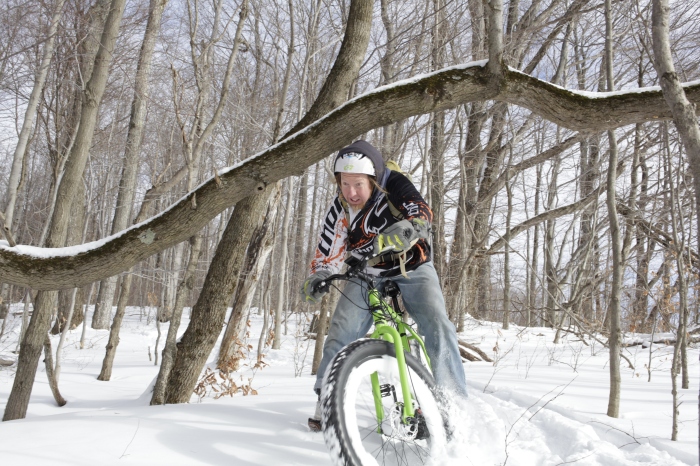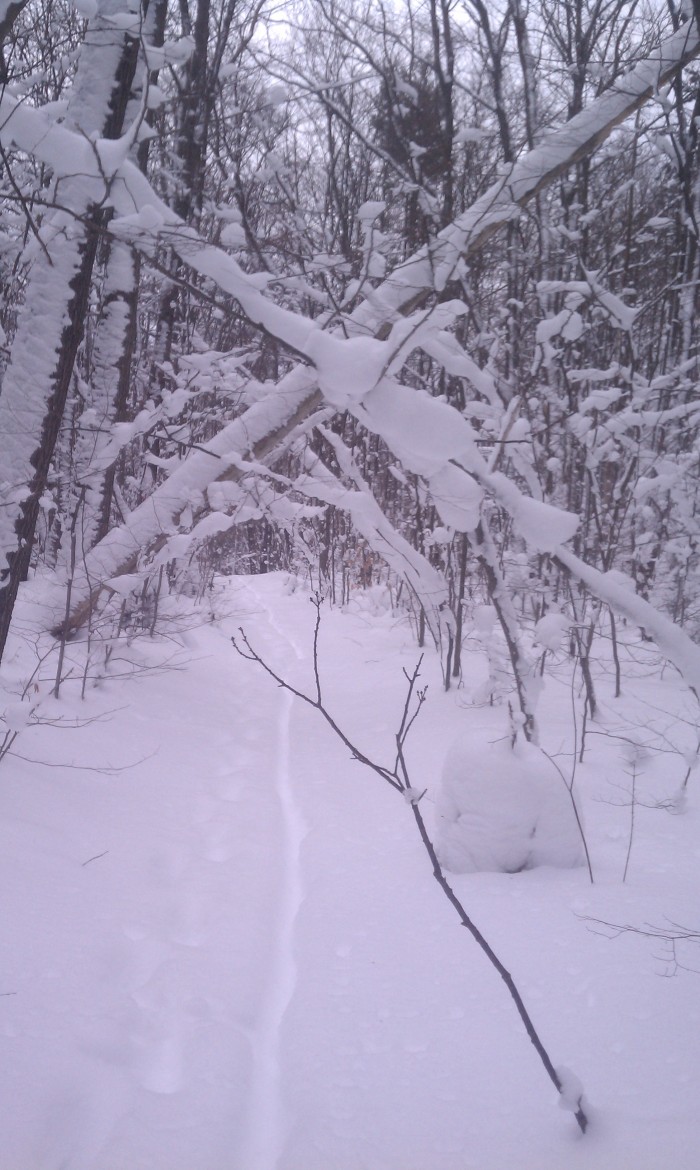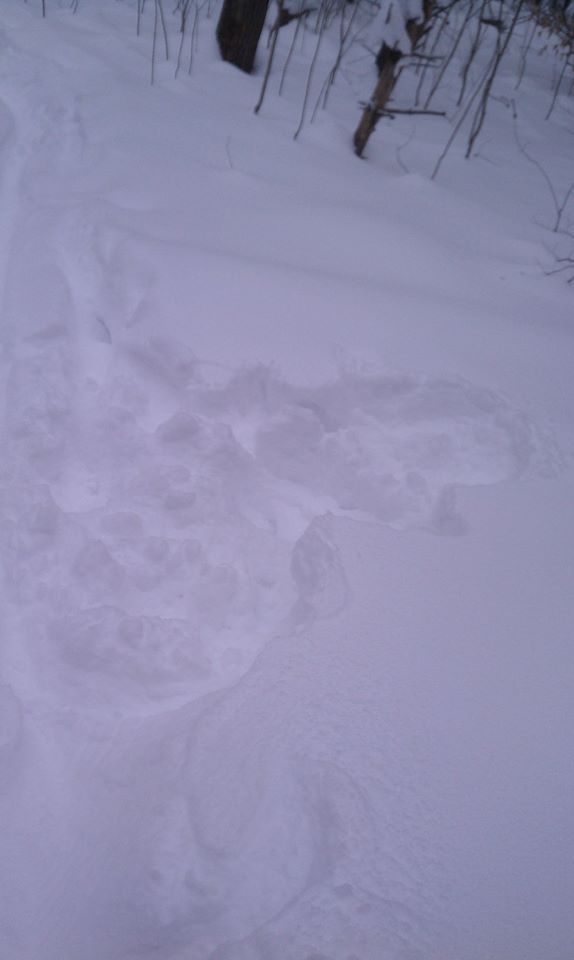One of the first times I took my BBS02 powered bike out in 6 inches of powder I found myself squealing like a 3-year-old girl and spending hours just riding around on my front lawn. There was something about riding in the snow where I felt totally and completely out of control, and it was good. The bike didn’t do what I wanted it to, the back wheel was constantly spinning out and I was left feeling like there was no way in hell I was ever going to be able to ride in that much snow in the woods with so little control.
It wasn’t long before I was able to control the bike and predict pretty accurately what is was going to do based on the conditions and where the tires ended up and how much throttle I was giving it. Hitting the singletrack was the next logical step.
I built a lot of trails at my wife’s house where she had a mile and a half long driveway that ascended almost 800 vertical feet. This is a perfect way to build snow trails as what you need is a slight incline on most of the trail so gravity will help you get moving when the traction is poor to non-existent. Once you hit the bottom you can ride your ebike up the plowed road back to the top and hit it again. Riding on singletrack like this is a strange combination of sledding, skiing and snowboarding.
1) The bike will go where the bike wants to go. In snow the bike will naturally slide into ditches or ruts, the tires will slide out when you are on a sideways fall line, and will naturally bank into snowbanks. You can fight the tendency the bike has to find the lowest point or you can learn to use it to accurately predict where the bike wants to go.
2) Riding position is everything. Pedaling is a luxury you can only afford on straight and level terrain where you are going straight up a hill or straight down a hill. If you are on a sideways incline or have sharp turns you will need to take your foot off the pedal on the side that is the inside of the turn or the uphill foot and be prepared to catch yourself as the bike inevitably slides out. Keep your other foot weighted on the pedal with your ass off the seat and keep your leg behind the pedal on the foot that you are going to put down to catch yourself. You don’t want to get bear-clawed by the empty pedal.
3) Manners are important. If you see someone else riding or XC skiing on the trail stop and wait for them to pass. Say hello if you want and bring a copy of HR 727 (print out a copy here and bring it with you everywhere you go) in case they harass you for riding an ebike on the trails. Your best course of action is always politeness and non-confrontational energy. In most places they have to work pretty hard to keep Motocross bikes off their trails so don’t be offended if they initially see you as cheating or breaking the law.
4) Different conditions require different riding styles. Riding in several inches of powder is going to be a lot tougher than riding on hardpacked XC ski trails. If you are riding on hardpack and your bike ends up in the powder you can quickly lose control from the rapid deceleration
5) Big studs on the tires like the Surly Lou 4.8 are great for traction. Nothing beats chains, you can buy them premade at Slipnotchains or build your own as shown here. There are also studded fat bike tires but in my opinion they are too expensive, not worth the weight and don’t make sense for singletrack bikes.
6) When making your own trails look for something with a lot of downhill. Big steep drops that are 35 degrees or more are a lot of fun if you are going straight down the fall line. Avoid building trails that slope off to the side more than about 10-15 degrees, you’ll spend all your time trying to keep your bike from sliding and be forced to ride much slower than you want to. Avoid building any trails that go uphill more than 10 degrees uphill, in deep snow you’ll end up having to walk your bike.
7) You can freeride in the woods where there are no trails which can be really fun, but be careful as you will inevitably hit hidden logs and stumps under the snow. Be prepared for anything. When falling follow step 8.
8) The most important rule of riding in the woods is DON’T LOOK AT THE TREES. Always look at where you want your bike to go, never ever look at something you don’t want to hit. Your body will find a way to make it happen if you look there, so just get in the habit of doing it. When you lose control and are taking a fall it is the most important time to relax and look at where you want to go. Snow is soft. Trees are hard.
9) Slow down, speed adds stability but also risk of injury when you lose control. When riding over logpiles or bridges that are a couple feet high, slow down, give yourself just enough power to get over without catching air. If you are jumping a log, the first time you hit it walk over it and see if the BBS02 will clear it. If it doesn’t then don’t jump it, walk it. Constantly beating your BBS02 against logs will eventually destroy the housing.
10) Width matters. Narrow tires will tend to track better, slide less and perform well in shallow snow and powder. Wider tires will be much sloppier, bouncier and tend to ride up on the snow more. A normal 26 Full Suspension bike can be just as much fun as a fatbike if the snow is not too deep and if there are not a lot of icy ruts. One way to make your fatbike tires wider is to buy wider rims/wheelsets. A 80mm rim will make a 4″ tire about 1/2″ wider than a 50mm rim. If your tires is already pretty close to the chainstays getting a bigger rim may make a tire that currently fits too big for your bike.
11) Tire pressure is king. “When in doubt let it out.” If you are not happy with your ride, try letting some air out of the tires. It works wonders. I ride 7psi in the front and 8psi in the rear but I’ve heard of people riding all the way down to 4-5psi. The lower you go the more traction you will have but at some point you’ll start to get pinchflats. Don’t go over 10psi in the snow. The large round dial pressure gauges are wildly inaccurate at low pressures. I use the cheap digital Slime gauge which I got for about $2 at Ollies. I leave one presta-schrader adapter on one of my tube stems for every one of my bikes so I can use my schrader tire gauge and my air compressor. You can buy them for about $.50 on ebay.
12) Keep your hands and feet warm. Dress in layers. My hands always get cold about 1/4 the way into the ride but then I warm up by the end. Gloves with liners are best and two hoods are better than one. It helps to be able to shed outer glove layers or hoods as most of your heat is lost from your head. Roll up that drive side pant leg as your BBS02 will shred your pants and yank your foot towards the drive system.
13) Stay off the front brake. I never cover the front brake and I only use it when I’m about to hit something hard. You’re almost always better off locking up the back brake and dragging your back tire along. It is far more predictable and you will be much less likely to bite it.
14) Have more fun than everyone else.
Ride On.
Karl




No comments:
Post a Comment